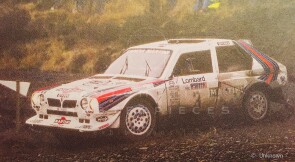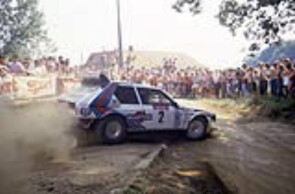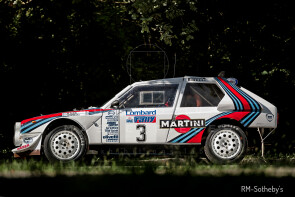
1985 Lancia Delta S4 Corsa
ON/OFF
Why am I an Automotive Masterpiece?
The Lancia Delta S4 was the only car of the Italian automotive group Fiat Auto, which at the time included the Fiat, Lancia, Autobianchi, Abarth and Alfa Romeo brands, to be created exclusively for sporting use; it had a demanding legacy, that of the Lancia Stratos and 037, and has little in common with the road version, created in 200 units to obtain FIA Group B homologation, necessary to participate in the World Rally Championship. Wanted by the racing department of the FIAT group to fight the new four-wheel drive cars from Audi and Peugeot, the project was developed starting from 1983 by Eng. Claudio Lombardi and Sergio Limoni, who took care of the engine and chassis parts, while the design it was entrusted to the architect Bruno Giardino, who had to follow the aesthetic lines of the Lancia Delta, as a matter of corporate marketing. The first prototype, called SE038-001, was completed in February 1984, followed by the following 5 experimental frames, which were never registered or homologated, but used only to develop and arrive at the final production of the 28 homologated racing frames called: “Lancia Delta S4”, where S stands for Supercharged and 4 indicates the drive wheels. The Delta S4 engine, positioned in the center of the car, is a 1759 cc in-line 4-cylinder in light alloy, with four valves per cylinder and a dual fuel system: turbo-charger and volumetric compressor. All these elements made Abarth engineers obtain the best possible balance, exceeding 500hp. The frame, built from a reticular structure of alloy tubes, had a double function: first of all it allowed a very light overall weight and then, it made it possible for the race assistants to easily reach all the mechanical parts for any type of necessary intervention. The central engine, the chassis, the four-wheel drive, the gearbox with frontal grafts and a very light body in fiberglass and carbon fiber, did not exceed 970 kg, obtaining a formidable weight to power ratio. The Delta S4 obtained homologation in June 1985 and made its debut in the world championship at the end of the year, presenting itself at the Lombard RAC Rally with two specimens entrusted to Henri Toivonen and Markku Alén, who immediately imposed themselves in the rally scene, obtaining the first two steps of the podium . The two crews, reconfirmed for the 1986 season, were joined, at the behest of Cesare Fiorio, by a third S4 entrusted to the couple Miki Biasion and Tiziano Siviero. The Delta S4 soon proved to be the car to beat, even though it won no title, it undoubtedly represented the highest expression of Group B cars. The tragic accident in May 1986 at the Tour de Corse, where Henri Toivonen and Sergio Cresto lost their life, along with other tragic events, prompted the FIA to suspend the activity of Group B in the World Rally Championship, in favor of less exasperated cars and closer to the road ones: thus Group A was born.
The Lancia Delta S4 chassis no. 207 is one of the first homologated specimens in 1985, it was this car that took part in the Lombard RAC Rally in Martini Racing livery with the provisional plate A637352; brought to the race by the legendary couple Markku Alén and Ilkka Kivimäki, it finished on the podium, obtaining the second place overall on its debut. In 1986 it was definitively registered (TO76797E) and sold to the Genoese team HF Grifone, for which it participated in the European Rally Championship, with Fabrizio Tabaton and Luciano Tedeschini. Thus, in 1986 it took part in the 24 Hours of Ypres in the Martini Racing livery and the Rally of Halkidikis and Antibes, in the black and gold livery of the Esso-Grifone team. In 1987 it participated in the European Autocross Championship, conducted in three races by Giovan Battista Rosella who secured the title with three first places.




